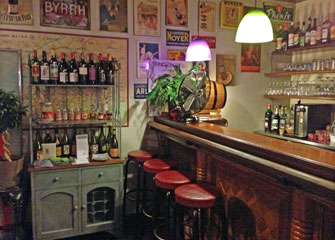
When I was invited to an event celebrating the publication of the new edition of Les Bistrots de Chef à Paris, by Claire Delbos and Gérard Cambon, I was surprised to find myself in a pretty restaurant near Bastille, La Canaille, that I had never heard of before. Leafing through the book, which features photos and descriptions of 28 restaurants and their chefs, with one recipe by each, I was again surprised to discover that I was unfamiliar with several of them.
The idea of the book is to spotlight bistros with talented chefs (most of them chef-owners) who revisit French tradition with quality seasonal ingredients while keeping their prices at a reasonable level. Among the new additions are the eateries of young chefs like Romain Tischenko at Le Galopin and recent arrivals in Paris like Patrick Gelbart at Youpi et Voilà, but there are also many old favorites like Olivier Gaslin at Le Villaret and Bruno Doucet at La Régalade. Then there are those unknown (to me) quantities. Unfortunately, not a single woman chef is featured in the book.
I resolved to return to La Canaille, which is pictured on the cover of the book, for a meal and soon had the opportunity after a gallery opening in the neighborhood. Its pleasing old-fashioned decor includes a wooden bar and furnishings; etched-glass partitions; tiled floors; and antique clocks and advertising

plaques on the walls. The two larger dining rooms are linked by a smaller one with big windows looking onto a garden. According to Les Bistrots de Chef, it was once a hangout for anarchists before Jean-Philippe Crouzet, the former chef at Gaspard de la Nuit and Chez Ramulaud, bought it in 2008.
There were six of us at the table, my friend Mary and her visiting relatives from Michigan, all female and all hearty eaters with a taste for French food.
I chose to start with an off-the-beaten-track dish for a French bistro, maki with smoked
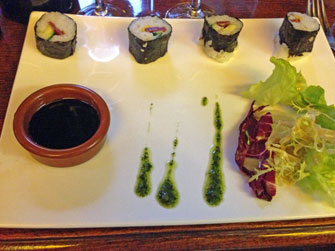
duck breast and mango, thinking it would be a good way to test the chef’s talents for fusing Asian and French flavors. Unfortunately, he failed this one. Both the duck and mango were overwhelmed by the vinegary sushi rice, while the rice itself was mushy.
My fellow diners did better with their more traditional (but not always French) starters: the attractively presented eggplant-and-ricotta millefeuille; antipasti of grilled vegetables
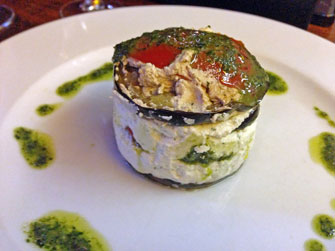
with thyme; brochettes of fried mozzarella, tomatoes and country ham; and the slightly
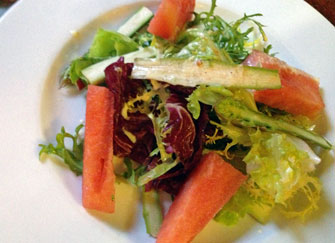
more adventurous asparagus and watermelon salad.
The main courses were heavy on meat, the only fish offering being a brandade of salmon with tarragon and crayfish. I enjoyed my flavorful veal steak with a sauce of Fourme d’Ambert
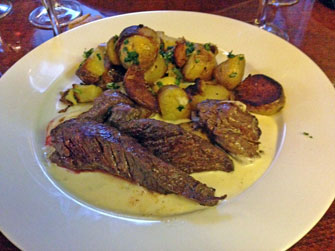
(a blue cheese from the Auvergne), served with fried potatoes. Mary found her confit de canard tasty but slightly dry. It came with a gravy made with ceps, but there was no sign of the
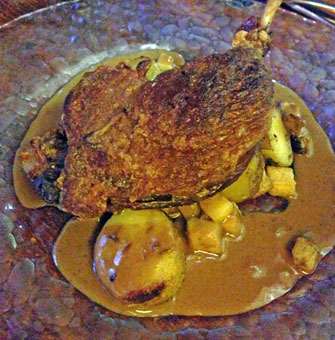
purée of celery with cumin promised on the menu, just more fried potatoes. The spelt risotto with smoked duck and Brie got a thumbs up, as did the brandade, but the real hit of the evening was the enormous entrecote
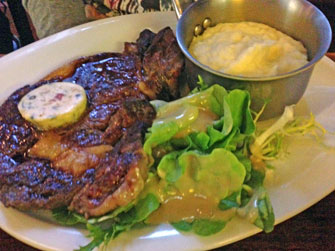
(for €3 extra), marbled with fat as it should be, and served with butter flavored with dried tomatoes and herbs.
Like the main courses, the desserts we sampled were rich and came in generous helpings: cheesecake with salted-butter caramel sauce; millefeuille with Morello cherries and white
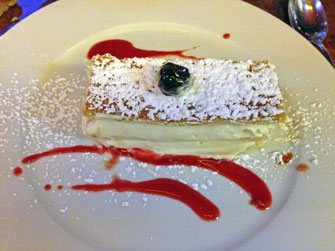
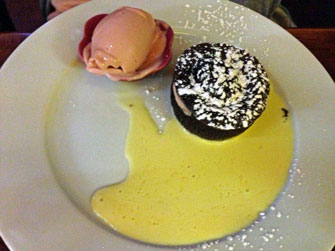
chocolate mousse; and a soft-centered chocolate cake.
As you may have guessed from the foregoing, La Canaille is not the place to go for the more refined cuisine of some of the other bistros in the book, notably those mentioned at the beginning of this article. It is, however, the place to go for hearty, unpretentious (as long as you skip the experiments like the maki) food and friendly, attentive service in a pleasing bistro setting.
Favorite